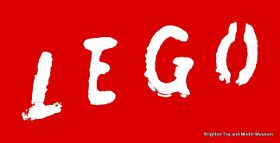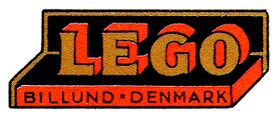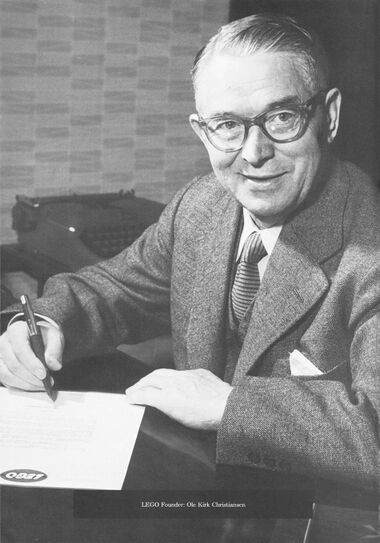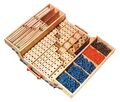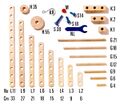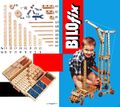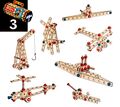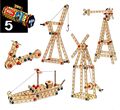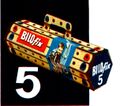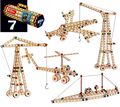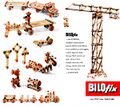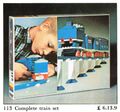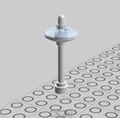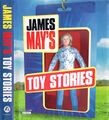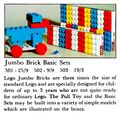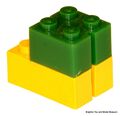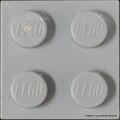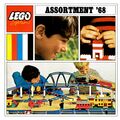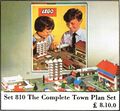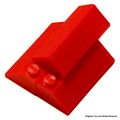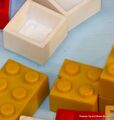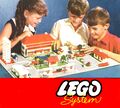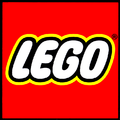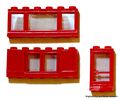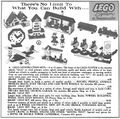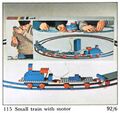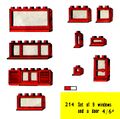Category:Lego (company)
From The Brighton Toy and Model Index
Jump to navigationJump to search
| Toy Brands and Manufacturers |
|---|
Lego (company) |
| 1932 - |
EVOLUTION OF LEGO:
Bricks: Original
|| Transitional
|| Modern
Town Plan
|| Cars
|| Roofs
|| Windows and Doors
|| Wheels
Ole Kirk Christiansen at his desk (image: Lego Group) [image info]
The Denmark-based Lego company (LEGO AS, known as The LEGO Group) is currently (as of 2019) the world's largest toy company.
Now synonymous with the Lego plastic brick construction system, the company originally made traditional wooden products.
Lego company timeline
- ~1917-1932
- Ole Kirk Christiansen works as a carpenter, making furniture. The business is hit badly by the world depression in the 1920s.
- 1930s
- It's suggested to Ole that perhaps he consider branching out into wooden toys, like the new yo-yo's that are all the rage.
- 1932
- Ole opens his new factory for making wooden toys (and also miscellaneous wooden household goods).
- The company invests strongly in equipment.
- 1934
- The company is officially renamed "LEGO", which is a play on the Danish "leg godt" ("play well"), but also includes the three letters of Ole's first name.
- 1945
- The company produces a wooden toy repeating pistol, the year the German occupation ends. This design becomes Ole's first patent.
- 1947
- The company again decides to invest heavily, this time in an injection moulding machine, to produce more detailed plastic parts for some of their wooden toys.
- The company also starts to produce a clone of Hilary Page's plastic clip-together "Kiddicraft Self-Locking Building Bricks", selling them as "Automatic Binding Bricks" – a similarly clumsy and awkward name.
- 1953
- The bricks are given the simpler name "Lego Mursten" ("Lego Bricks").
- ~1955
- Told that toyshops like "system" toys with add-on sales, Ole renames the Lego Mursten range as Lego System. The company produces a Lego Town Plan Set baseboard printed with roads, that can be supplied with toy cars and trees, and enough Lego to create small buildings.
- 1958-
- After being told by exacting German buyers that the bricks' design is not sufficiently impressive, the company redesigns the brick underside to incorporate extra protrusions that guarantee that every stud is gripped at at least three points. This is now the modern Lego brick.
- The redesign also adds new clip-in door and window pieces (the earlier system has relied on the bricks having side-slots)
- The redesign also adds angled roof-bricks. Previously, the Page system used cardboard for roofing, and the Lego system had had to rely on unrealistic stepped standard blocks.
- 1959
- Since the LEGO name is increasingly being associated abroad with just the bricks, the company decides to rebrand all their existing wooden products as BILOfix.
- 1960
- After a fire, the company decides not to to rebuild the wooden toy production capability. From now on "Lego means Lego".
- 1961
- Samsonite start producing Lego in the USA
- 1960s-
- The BILOfix wooden toys brand is taken over by two family members. Their separate company produce "Bilofix Engineer" as just "Bilofix".
- 1962
- Lego gains wheels! The official wheel-related R&D is considered unsuccessful, but an employee has quietly worked on an unofficial alternative design, and it is adopted.
- 1966
- The Lego Train System is introduced. It includes a large black motorised block, a battery compartment that can be converted into a locomotive tender, and plastic rails that clip onto the studs of Lego strips, used as railway sleepers.
- 1968
The first Legoland theme park opens in Billund, Denmark.
- 1969
- Lego Duplo appears. This is a double-size version of Lego for smaller children. The a 2×2 standard brick fits onto a single Duplo stud, and 4×2 standard brick fits onto a pair of adjacent Duplo studs. Although Hilary Page had had a similar system (as did the Samsonite Lego range), the new design cleverly has a hole in the top of each large Duplo peg to accommodate the cylinder under each "new-style" post-1956 Lego brick.
- 1972
- Hollow floating "ship hull" pieces allow the resulting Lego boats to be used as floating bath toys.
- ~1978
- Introduction of the complete Lego "MiniFigure"
- 1982
- Lego Expert becomes Lego Technic.
- A limited-edition book Fifty Years of Play is published as the official company history to mark the 50th anniversary.
- 1996
- Legoland Windsor opens in the UK.
- 1999
- Lego Star Wars, the first Lego "licenced" range.
- Legoland California opens.
- 2002
- The first Lego Store opens, in Cologne, Germany.
- 2011
- Legoland Florida opens.
- 2012
- Legoland Malaysia.
- 2014
- Release of The Lego Movie.
- 2016
- Legoland Dubai
- 2017
- Release of The Lego Batman Movie.
- Legoland Japan
See also:
External links
Subcategories
This category has the following 22 subcategories, out of 22 total.
*
A
- Lego 1:87 accessories (2 P, 12 F)
- Lego accessory packs (10 P, 32 F)
- Automatic Binding Bricks - Lego Mursten (Lego) (1 P, 5 F)
B
- BILOfix (2 P, 10 F)
C
- Lego 1:87 cars and other vehicles (1 P, 22 F)
- Lego Creator (2 F)
D
- Lego Digital Designer (LDD) (1 P, 6 F)
E
- Early Lego sets (5 P, 12 F)
L
M
- Modern Lego Bricks (Lego) (empty)
R
- Lego roof bricks (1 P, 7 F)
S
- Lego System by Samsonite (6 F)
T
- Lego Technic (1 P, 6 F)
W
- Lego wheels (3 P, 5 F)
- Lego windows and doors (1 P, 4 F)
Pages in category ‘Lego (company)’
The following 47 pages are in this category, out of 47 total.
B
C
F
L
Media in category ‘Lego (company)’
The following 148 files are in this category, out of 148 total.
- Angle and Valley Corner Tiles, Lego Set 283 (LegoCat ~1960).jpg 689 × 952; 67 KB
- Balcombe Viaduct (Ouse Valley Viaduct), Lego Digital Designer.jpg 995 × 560; 99 KB
- Base Plates, Lego Set 227 (LegoCat ~1960).jpg 689 × 952; 96 KB
- Base Plates, Lego Set 228 (LegoCat ~1960).jpg 689 × 952; 87 KB
- Base Plates, Lego Set 229 (LegoCat ~1960).jpg 689 × 952; 94 KB
- Battery Case, Lego 101 (LegoAss 1968).jpg 1,498 × 669; 166 KB
- Bevelled Bricks, Lego Set 280 (LegoCat ~1960).jpg 689 × 952; 56 KB
- Bevelled Bricks, Lego Set 281 (LegoCat ~1960).jpg 689 × 952; 70 KB
- Bevelled Bricks, Lego Set 282 (LegoCat ~1960).jpg 689 × 952; 65 KB
- Billinton E2 0-6-0 tank locomotive, Lego Digital Designer.jpg 598 × 449; 67 KB
- Bilofix Chest (Bilofix ~1960s).jpg 2,057 × 1,745; 401 KB
- BILOfix Component Parts (BILOfix ~1960s).jpg 1,200 × 1,038; 167 KB
- BILOfix leaflet (BILOfix 1960s).jpg 1,200 × 1,069; 204 KB
- BILOfix logo.jpg 1,890 × 723; 72 KB
- BILOfix models, examples (Bilofix ~1960s).jpg 3,000 × 1,357; 520 KB
- BILOfix Set 3, examples (BILOfix ~1960s).jpg 1,800 × 1,601; 321 KB
- BILOfix Set 5, examples (BILOfix ~1960s).jpg 1,800 × 1,649; 379 KB
- BILOfix Set 5, packaging (BILOfix ~1960s).jpg 1,211 × 1,069; 145 KB
- BILOfix Set 7, examples (BILOfix ~1960s).jpg 1,800 × 1,606; 385 KB
- BILOfix The Toy That Teaches (BILOfix ~1960s).jpg 1,200 × 1,067; 209 KB
- Breakdown Lorry, Lego 256 (LegoCat ~1960).jpg 689 × 476; 48 KB
- Brighton Toy and Model Museum (Lego model).jpg 1,024 × 512; 67 KB
- Brighton Toy and Model Museum rendered in Lego (LDD).jpg 1,280 × 998; 289 KB
- Building Instructions, Lego (LegoCat ~1960).jpg 2,500 × 1,683; 324 KB
- Chain Pier, Brighton, Lego Digital Designer.jpg 819 × 459; 92 KB
- Church Special Box, Lego Set 309 (LegoCat ~1960).jpg 689 × 952; 75 KB
- Complete Train Set, Lego 113 (LegoAss 1968).jpg 1,511 × 1,414; 361 KB
- Corner Bricks, Lego Set 217 (LegoCat ~1960).jpg 689 × 952; 67 KB
- Curved Bricks, Lego Set 224 (LegoCat ~1960).jpg 689 × 952; 59 KB
- Cyclists and Motorcyclists, Lego Set 270 (LegoCat ~1960).jpg 689 × 476; 62 KB
- Double Garage Special Box, Lego Set 306 (LegoCat ~1960).jpg 689 × 952; 84 KB
- E-Type Jaguar in Garage, Lego 670 (Lego ~1964).jpg 702 × 488; 68 KB
- Eight-Stud Bricks, Lego Set 218 (LegoCat ~1960).jpg 689 × 952; 67 KB
- Electronic control (LegoAss 1968).jpg 1,600 × 1,202; 343 KB
- ESSO Lorry, Lego 251 (LegoCat ~1960).jpg 689 × 476; 44 KB
- Esso Petrol Pumps and Sign, Lego Set 231 (Lego ~1964).jpg 702 × 488; 53 KB
- ESSO Petrol Pumps, Lego Set 231 (LegoCat ~1960).jpg 689 × 476; 59 KB
- ESSO Tanker, Lego 250 (LegoCat ~1960).jpg 689 × 476; 51 KB
- ESSO Trailer, Lego 252 (LegoCat ~1960).jpg 689 × 476; 36 KB
- Fifty Lettered Bricks, Lego Set 234 (LegoCat ~1960).jpg 689 × 952; 65 KB
- Fifty Numbered Bricks, Lego Set 237 (LegoCat ~1960).jpg 689 × 952; 67 KB
- Fire Engine with Ladder, Lego 255 (LegoCat ~1960).jpg 689 × 476; 61 KB
- Fire Station Special Box, Lego Set 308 (LegoCat ~1960).jpg 689 × 952; 86 KB
- Ford Taunus in Garage, Lego 263 (Lego ~1964).jpg 702 × 488; 64 KB
- Four-Stud Bricks, Lego Set 220 (LegoCat ~1960).jpg 689 × 952; 59 KB
- Garage Base with Automatic Door, Lego Set 235 (LegoCat ~1960).jpg 689 × 952; 86 KB
- Garage with Automatic Door, Lego Set 236 (LegoCat ~1960).jpg 689 × 952; 77 KB
- House with Garage, Lego PlanPack 324 (LegoAss 1968).jpg 1,534 × 708; 188 KB
- I360 (Lego Digital Designer).jpg 786 × 772; 54 KB
- Ideas Book (LegoAss 1968).jpg 1,543 × 702; 148 KB
- Illuminating Brick, Lego Set 245 (LegoCat ~1960).jpg 689 × 952; 67 KB
- International Flags, Lego Set 242 (LegoCat ~1960).jpg 689 × 952; 55 KB
- James Mays Toy Stories, cover and spine (ISBN 9781844861071).jpg 1,451 × 1,600; 1.39 MB
- Jeep, Lego PlanPack 330 (LegoAss 1968).jpg 1,543 × 776; 187 KB
- Jumbo Bricks, Basic Sets, Lego 501 502 503 (LegoAss 1968).jpg 1,534 × 1,467; 363 KB
- Karmann Ghia in Garage, Lego 265 (Lego ~1964).jpg 702 × 488; 62 KB
- Kiddicraft and Lego bricks.jpg 675 × 500; 49 KB
- Kiddicraft brick (green) and Lego Mursten brick (yellow).jpg 1,600 × 1,548; 147 KB
- Large Base Plate, Lego 700 E (LegoCat ~1960).jpg 1,378 × 952; 134 KB
- Large Wheels, Lego Set 401 (Lego ~1964).jpg 702 × 976; 87 KB
- Large-Size Lego Blocks, Samsonite (Schwarz 1967).jpg 2,739 × 1,247; 459 KB
- Lego 2x2 Brick.jpg 1,602 × 1,601; 143 KB
- Lego 2x4 Brick, top view.jpg 1,600 × 800; 88 KB
- Lego and Lego Technic, brick profiles, evolution.jpg 1,062 × 629; 125 KB
- Lego Assortment 68, catalogue cover (Lego 1968).jpg 1,595 × 1,600; 518 KB
- Lego Basic Sets (LegoCat ~1960).jpg 1,600 × 1,069; 221 KB
- Lego Building Instructions (Lego ~1964).jpg 2,000 × 1,349; 296 KB
- Lego company logo (1934).jpg 2,600 × 640; 67 KB
- Lego Complete Town Plan Set, Lego 810 (Lego 1968).jpg 1,480 × 1,375; 423 KB
- Lego Creator 4939 Sports Car.jpg 1,024 × 768; 300 KB
- Lego Creator logo.jpg 923 × 203; 31 KB
- Lego Halloween Spider (2012).jpg 1,024 × 768; 495 KB
- Lego logo, stamped on a wooden toy (1930s).jpg 648 × 331; 57 KB
- Lego Mechanical Sets, Samsonite (Schwarz 1967).jpg 2,000 × 1,495; 481 KB
- Lego Mursten aeroplane, end-slots (Lego ~1953).jpg 1,862 × 1,426; 1.36 MB
- Lego Mursten logo (~1953).jpg 2,000 × 751; 452 KB
- Lego Mursten Set (Lego ~1953).jpg 2,000 × 1,435; 521 KB
- Lego Mursten slotted brick, underside, branded (Lego ~1953).jpg 1,600 × 1,047; 265 KB
- Lego roof bricks (Lego, 1960s).jpg 2,500 × 2,500; 289 KB
- Lego Roof Bricks, lineart (Patent 3034254, 1959-1962).jpg 1,159 × 881; 215 KB
- Lego Second Generation bricks (Lego).jpg 1,515 × 1,600; 194 KB
- Lego Sets (Lego ~1964).jpg 1,600 × 1,089; 230 KB
- Lego Store, Brighton BN1 2TF.jpg 2,200 × 1,239; 1.42 MB
- Lego System (LegoCat ~1960).jpg 2,099 × 1,882; 586 KB
- Lego System by Samsonite, logo (1960s).jpg 793 × 521; 90 KB
- Lego System logo (1968).jpg 1,507 × 772; 88 KB
- Lego System range, Samsonite (Schwarz 1962).jpg 2,200 × 1,458; 549 KB
- Lego System single-sheet catalogue (LegoCat ~1960).jpg 2,500 × 1,264; 618 KB
- Lego System single-sheet catalogue (LegoCat ~1964).jpg 1,600 × 813; 329 KB
- Lego Technic beams.jpg 1,024 × 575; 310 KB
- Lego Technic helicopter 42020.jpg 1,024 × 768; 378 KB
- Lego Technic Helicopters 42020.jpg 1,024 × 766; 95 KB
- Lego Technic Logo.jpg 2,330 × 410; 81 KB
- Lego Technic pegs.jpg 1,024 × 767; 481 KB
- Lego Town Plan Board, Lego 200 (LegoCat ~1960).jpg 699 × 1,162; 132 KB
- Lego Town Plan Set, Samsonite (Schwarz 1962).jpg 1,993 × 1,641; 302 KB
- Lego trademarked logo.png 713 × 715; 39 KB
- Lego Train Accessories 150-156 (LegoAss 1968).jpg 3,000 × 1,500; 449 KB
- Lego wheel and axle design (Patent 3234683, s1962).jpg 508 × 795; 87 KB
- Lego wheels and axles (Lego, 1960s).jpg 3,000 × 2,294; 398 KB
- Lego windows and doors (Lego, 1960s).jpg 3,000 × 2,504; 464 KB
- Lego windows, lineart (Patent 3284946, 1964-1966).jpg 1,056 × 798; 144 KB
- Lego wooden toys decal (~1939-).jpg 2,355 × 987; 249 KB
- Little House, Lego Set 211 (LegoCat ~1960).jpg 689 × 476; 54 KB
- Little House, Lego Set 212 (LegoCat ~1960).jpg 689 × 476; 51 KB
- Little House, Lego Set 213 (LegoCat ~1960).jpg 689 × 476; 50 KB
- Little Shop, Lego Set 210 (LegoCat ~1960).jpg 689 × 476; 51 KB
- Locomotive with Motor, Lego 112 (LegoAss 1968).jpg 1,496 × 673; 162 KB
- London Bus, Lego PlanPack 313 (LegoAss 1968).jpg 1,534 × 698; 164 KB
- Mercedes 190SL in Garage, Lego 266 (Lego ~1964).jpg 702 × 488; 64 KB
- Mercedes-Benz in Garage, Lego 264 (Lego ~1964).jpg 702 × 488; 68 KB
- Motor with Three Sets of Wheels, Lego 100 (LegoAss 1968).jpg 1,490 × 678; 177 KB
- No Limit With Lego, Samsonite (Schwarz 1967).jpg 2,000 × 1,985; 650 KB
- Ole Kirk Christiansen at his desk, publicity photograph (LegoGroup).jpg 2,098 × 3,000; 1.33 MB
- Opel Rekord in Garage, Lego 262 (Lego ~1964).jpg 702 × 488; 64 KB
- Petrol Station Special Box, Lego Set 310 (LegoCat ~1960).jpg 689 × 952; 89 KB
- Removal Van, Lego 257 (LegoCat ~1960).jpg 689 × 476; 48 KB
- Road Signs, Lego Set 232 (Lego ~1964).jpg 702 × 488; 46 KB
- Road Signs, Lego Set 232 (LegoCat ~1960).jpg 689 × 476; 54 KB
- Seven Beams with Names, Lego Set 226 (LegoCat ~1960).jpg 689 × 952; 62 KB
- Shell Garage, Lego PlanPack 325 (LegoAss 1968).jpg 1,543 × 697; 195 KB
- Single-Stud Bricks, Lego Set 222 (LegoCat ~1960).jpg 689 × 952; 64 KB
- Single-Stud Bricks, Round, Lego Set 223 (LegoCat ~1960).jpg 689 × 952; 64 KB
- Six-Stud and Eight-Stud Beams, Lego Set 225 (LegoCat ~1960).jpg 689 × 952; 71 KB
- Six-Stud Bricks, Lego Set 219 (LegoCat ~1960).jpg 689 × 952; 67 KB
- Sixteen-Stud Beams, Lego Set 225 (LegoCat ~1960).jpg 689 × 952; 69 KB
- Small Train with Motor, Lego 115 (LegoAss 1968).jpg 1,486 × 1,404; 362 KB
- Small Train Without Motor, Lego 111 (LegoAss 1968).jpg 1,502 × 683; 183 KB
- Small Wheels, Lego Set 400 (Lego ~1964).jpg 702 × 976; 70 KB
- Street Lamps, Lego Set 233 (Lego ~1964).jpg 702 × 488; 37 KB
- Street Lamps, Lego Set 233 (LegoCat ~1960).jpg 689 × 476; 42 KB
- Super Train Set, Lego 119 (LegoAss 1968).jpg 2,992 × 1,540; 903 KB
- Taxi, Lego PlanPack 315 (LegoAss 1968).jpg 1,543 × 695; 197 KB
- Tipper Truck, Lego 253 (LegoCat ~1960).jpg 689 × 476; 46 KB
- Trailer, Lego 254 (LegoCat ~1960).jpg 689 × 476; 36 KB
- Trees and Bushes, Lego Set 230 (LegoCat ~1960).jpg 689 × 476; 48 KB
- Turntables, Lego Set 402 (Lego ~1964).jpg 702 × 976; 69 KB
- Twenty-Stud Beams, Lego Set 216 (LegoCat ~1960).jpg 689 × 952; 72 KB
- Two-Stud Bricks, Lego Set 221 (LegoCat ~1960).jpg 689 × 952; 61 KB
- Vauxhall Victor Estate in Garage, Lego 671 (Lego ~1964).jpg 702 × 488; 64 KB
- Volk's Electric Railway car, Lego Digital Designer.jpg 768 × 405; 69 KB
- Volkswagen 1500 in Garage, Lego 267 (Lego ~1964).jpg 702 × 488; 65 KB
- Volkswagen Beetle in Garage, Lego 261 (Lego ~1964).jpg 702 × 488; 65 KB
- VW Car Showroom Special Box, Lego Set 307 (LegoCat ~1960).jpg 689 × 952; 89 KB
- VW Delivery Van, Lego 258 (LegoCat ~1960).jpg 689 × 476; 36 KB
- VW Saloon Car in Special Case, Lego Set 261 (LegoCat ~1960).jpg 689 × 476; 59 KB
- VW Saloon Car, Lego 260 (LegoCat ~1960).jpg 689 × 476; 43 KB
- Windows and Door, Lego Set 214 (LegoCat ~1960).jpg 1,435 × 1,421; 203 KB

